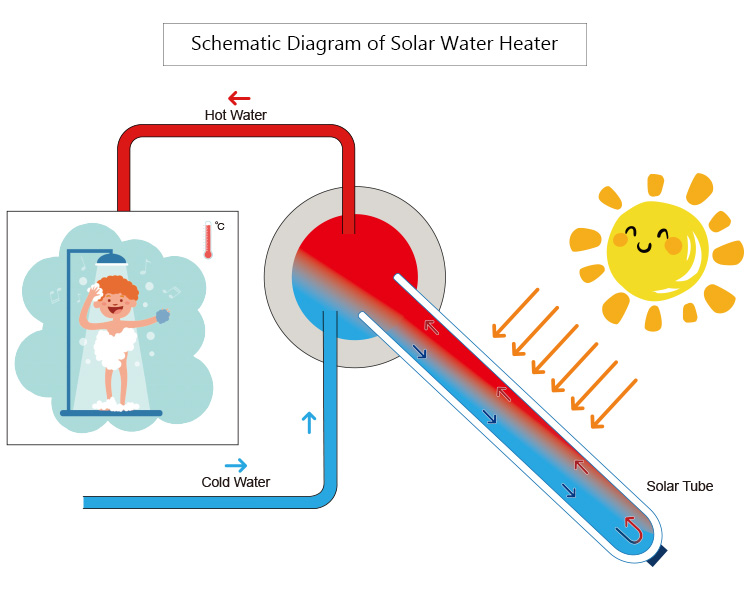Views: 48 Author: Site Editor Publish Time: 2021-12-09 Origin: Site

Heating principle of solar water heater
Sunlight passes through the first layer of glass of the heat-absorbing tube and shines on the black heat-absorbing layer of the second layer of glass, which absorbs the heat of the solar energy. Since the two layers of glass are vacuum insulated, the heat transfer will be greatly reduced. (Radiation heat transfer still exists, but there is no heat conduction and heat convection), most of the heat can only be transferred to the water in the glass tube, so that the water in the glass tube is heated, and the heated water moves up along the heating surface of the glass tube. Into the heat preservation water storage bucket, the relatively low temperature water in the bucket enters the glass tube along the backlight surface of the glass tube to replenish, so that the water in the heat preservation water storage bucket is continuously heated to achieve the purpose of hot water.
Solar water heaters convert sunlight energy into heat energy and heat water from low temperature to high temperature to meet people's hot water use in life and production. According to the structure, solar water heaters are divided into vacuum tube solar water heaters and flat panel solar water heaters. Vacuum tube solar water heaters are the main ones, occupying 95% of the domestic market share. Vacuum tube type domestic solar water heaters are composed of heat collection tubes, water storage tanks, brackets and other related accessories. The conversion of solar energy into heat energy mainly relies on heat collection tubes. The heat collecting tube uses the principle of hot water floating up and cold water sinking, so that the water generates micro-circulation to reach the required hot water.
Heat absorption process of solar water heater
When the evacuated tube water heater absorbs heat, solar radiation passes through the outer tube of the evacuated tube, is absorbed by the heat-collecting coating, and is transferred to the water in the tube along the inner tube wall. After the water in the tube absorbs heat, the temperature rises, the specific gravity decreases and rises, forming an upward power, forming a thermosyphon system. As the hot water continues to move up and is stored in the upper part of the water storage tank, while the lower temperature water is continuously replenished along the other side of the pipe and circulates in this way, the whole tank of water eventually rises to a certain temperature.
Flat-plate water heaters are generally split-type water heaters. The medium circulates naturally in the heat collecting plate due to thermosyphon, and the heat of the solar radiation on the heat collecting plate is transmitted to the water tank in time. The heat exchange in the water tank (jacket or coil) transfers The heat is transferred to the cold water. The medium can also be circulated through the pump to achieve heat transfer.
Solar water heater circulation pipeline
Domestic solar water heaters usually work in a natural circulation mode without external power. The evacuated tube solar water heater is a direct plug-in structure, and the hot water is powered by gravity. Flat-plate solar water heaters are powered by the pressure of tap water (called top water). The solar central heating system adopts pump circulation.
The above introduced the principle of domestic solar water heater heating, as well as the heat absorption process and circulation pipeline. After a detailed introduction, we have a clear understanding of how solar water heaters work. Of course, in addition to understanding the working principle of solar water heaters, we also need to understand its internal related parts before they can be used better.